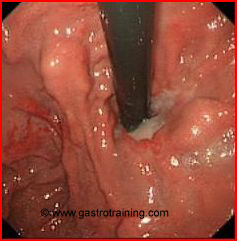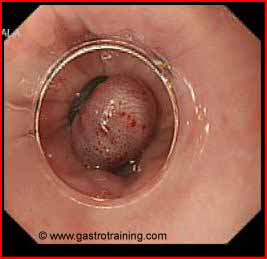Variceal Bleed
When should you screen for varices?
Gastro oesophageal varices are present in approximately 50% of patients with cirrhosis. Their presence correlates with the severity of liver disease; while only 40% of Child A patients has varices, they are present in 85% of Child C patients. Gastric varices are less prevalent than oesophageal varices and are present in 5%-33% of patients with portal hypertension with a reported incidence of bleeding of about 25% in 2 years, with a higher bleeding incidence for fundal varices.
In patients who have compensated cirrhosis and no varices on the initial OGD, it should be repeated in 3 years. If there is evidence of hepatic decompensation, OGD should be done at that time and repeated annually. In patients with small varices that have not bled and who are not receiving beta-blockers, OGD should be repeated in 2 years.
Define small and large varices?
Varices are either small or large. Large varices (for the purpose of treatment) are those varices that are greater than 5 mm or tortuous veins or occupying more than one-third of the oesophageal lumen.
Discuss primary prophylaxis options for varices?
- Non selective beta-blockers (propanolol, nadolol) prevent bleeding in more than half of patients with large varices) by reducing portal pressure by decreasing cardiac output) and, more importantly, by producing splanchnic vasoconstriction, thereby reducing portal blood flow. Selective beta-blockers (atenolol, metoprolol) are less effective and are suboptimal for primary prophylaxis of variceal haemorrhage. 1 bleeding episode is avoided for every 10 patients treated with beta-blockers. Propanolol is usually started at a dose of 20 mg twice a day (BID) and Nadolol is usually started at a dose of 40 mg once a day and) is adjusted to maximal tolerated doses. The most common side effects related to beta-blockers in cirrhosis are light headedness, fatigue, and shortness of breath. Some of these side effects disappear with time or after dose reduction.
- EVL can be considered for primary prophylaxis in patients with contraindications or intolerance or non-compliance to beta -blockers. If a patient is treated with EVL, it should be repeated every 1-2 weeks until obliteration with the first surveillance OGD performed 1-3 months after obliteration and then every 6-12 months to check for variceal recurrence.
- Nitrates (either alone or in combination with beta-blockers), shunt therapy, or sclerotherapy should not be used in the primary prophylaxis of variceal haemorrhage
Where would you consider primary prophylaxis?
- In patients with cirrhosis and small varices that have not bled but have criteria for increased risk of haemorrhage (Child B/C or presence of red wale marks on varices), nonselective beta-blockers should be used for the prevention of first variceal haemorrhage
- In patients with medium/large varices that have not bled but have a high risk of haemorrhage (Child B/C or variceal red wale markings on endoscopy), non selective beta-blockers or EVL may be recommended for the prevention of first variceal haemorrhage.
- In patients with medium/large varices that have not bled and are not at the highest risk of haemorrhage (Child A patients and no red signs), nonselective beta-blockers (propanolol, nadolol) are preferred and EVL should be considered in patients with contraindications or intolerance or non-compliance to beta-blockers.
Discuss management of acute variceal bleed?
- Resuscitation- aim for a haemoglobin of approximately 8 g/dL. This is based on experimental studies that show that restitution of all lost blood leads to increases in portal pressure to levels higher than baseline, and to more rebleeding and mortality.
- Pre endoscopic treatment- Terlipressin should be given to patients suspected of variceal haemorrhage. A RCT showed that bleeding control was significantly better with terlipressin compared with the placebo group. Mortality due to bleeding episodes was significantly lower in the terlipressin group at day 15 but this effect was not maintained over the loner time scale. Two RCTs showed that somatostatin use did not cause reduced rebleeding or mortality. One of these trial showed an improvement in the rate of haemostasis with somatostatin. There are no trails for the pre endoscopic use of octreotide
- Early Endoscopy (within 12-24 hrs) after resuscitation. Variceal band ligation therapy is superior to sclerotherapy in terms of rebleeding, all cause mortality and death due to bleeding in patients with bleeding oesophageal varices.
- Post endoscopic therapy-After endoscopic treatment of oesophageal variceal haemorrhage patients should receive vasoactive drug treatment (terlipressin for 48 hrs, octreotide or high dose somatostatin each for 3-5 days). Combination therapy (endoscopic treatment plus vasoactive drugs) has been shown to be superior in terms of better haemostasis and reduced early rebleeding rates. There is no survival benefit. (NB- High dose somatostatin- 500mcg bolus followed by 500 mcg/hr, octreotide- 50 mcg bolus followed by 25-50 mcg/hr, Terlipressin- 1-2 mg IV 4-6 hrly)
- Antibiotic therapy (ceftriaxone 1gm/day or ciprofloxacin 400 mg BD- maximum 7 days) should be commenced in patients with chronic liver disease who present with upper GI bleed. Antibiotic use significantly reduces mortality in this group of patients.
Discuss management of bleeding varices not controlled by endoscopy?
These patients should be managed in two stages:
- Initial emergency therapy to arrest blood loss- balloon tamponade achieves haemostasis in 80-95% of patients with either oesophageal or gastric varices. (complications of balloon tamponade- oesophageal tear, pneumonia and discomfort)
- Second line therapy to treat the underlying cause- TIPS is considered the therapy of choice.
Discuss prevention of variceal bleed?
Recurrence of variceal bleed can be as high as 80% within a year.
- Variceal band ligation (EVL) combined with a beta blocker (propanolol or nadolol) is recommended for secondary prevention for oesophageal variceal haemorrhage (most trials use propanolol 160 mg LA OD). EVL should be repeated every 1-2 weeks until obliteration with the first surveillance EGD performed 1-3 months after obliteration and then every 6-12 months to check for variceal recurrence.
- In patients unsuitable for variceal band ligation combination of non selective beta blocker and nitrates (ISMN- 20mg BD and increased to 40 mg BD) is recommended for secondary prevention of oesophageal variceal haemorrhage.
- TIPS should be considered to prevent oesophageal rebleeding in patients with contraindications, intolerance to or failure of endoscopic and/or pharmacological therapy.
Discuss gastric varices?
Types
Gastro-oesophageal (GOV) Type 1- these gastric varices are in continuity with oesophageal varices extending less than 5 cms along the lesser curve of the stomach.
GOV type 2- those which are in continuity with oesophageal varices but which extend further towards the fundus.
Isolated gastric varices (IGV) – are classified according to whether they are found in the fundus (IGV type 1) or elsewhere in the stomach (IGV type 2)
Management
- Patients with confirmed gastric variceal bleed should have endoscopic therapy preferably with cyanoacrylate injection. A retrospective study suggested that cyanoacrylate was more cost effective than TIPS. There were no significant differences in mortality or rebleeding between the two treatments. Most patients had GOV type 1 varices.
- Prevention of rebleed- there are no placebo controlled studies to examine the efficacy of beta blockers in preventing rebleeding in gastric varices. TIPS should be considered to prevent gastric variceal rebleed.
Pic 1 Oesophageal varices

Pic 3 Banded oesophageal varices
Ref
- British Society of Gastroenterology guidelines on the Management of Variceal Haemorrhage in Cirrhotic Patients.
- http://www.sign.ac.uk/guidelines/fulltext/105/index.html (Adopted by BSG)
- AASLD Practice Guidelines. Prevention and Management of Gastroesophageal Varices and Variceal Haemorrhage in Cirrhosis.








